WHMIS 2015 – Pictograms Fact Sheets
WHMIS 2015 – PICTOGRAMS
Important Information
Canada has aligned the Workplace Hazardous Materials Information System (WHMIS) with the Globally Harmonized System of Classification and Labelling of Chemicals (GHS).
This document discusses the WHMIS 2015 supplier requirements as regulated by the federal legislation – the Hazardous Products Act and the Hazardous Products Regulations (HPR).
Health Canada is the government body responsible for the overall WHMIS supplier-related laws. Note that WHMIS is also regulated in the workplace by the provinces, territories and federal (for federally regulated workplaces) governments under their occupational health and safety legislation. While these jurisdictions based their WHMIS regulations on the common model, small variations between jurisdictions may exist in how they adopted WHMIS 2015.
Suppliers and employers must use and follow the WHMIS 2015 requirements for labels and safety data sheets (SDSs) for hazardous products sold, distributed, or imported into Canada.
What is a pictogram?
Pictograms are graphic images that immediately show the user of a hazardous product what type of hazard is present. With a quick glance, you can see, for example, that the product is flammable, or if it might be a health hazard.
Most pictograms have a distinctive red “square set on one of its points” border. Inside this border is a symbol that represents the potential hazard (e.g., fire, health hazard, corrosive, etc.). Together, the symbol and the border are referred to as a pictogram. Pictograms are assigned to specific hazard classes or categories.
The graphic below shows hazard pictograms. The bold type is the name given to the pictogram; the words in the brackets describe the hazard.
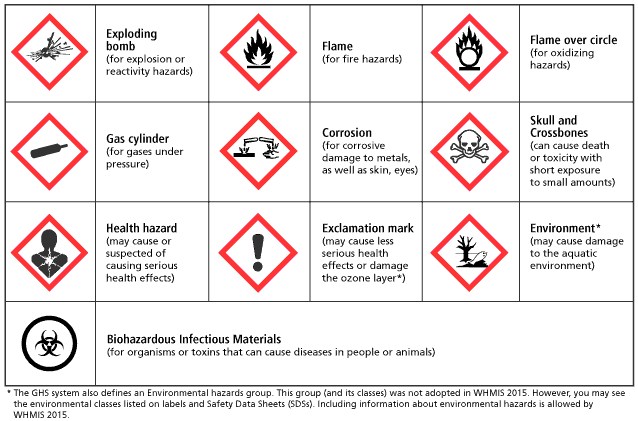
What pictograms are used with WHMIS 2015 hazard classes and categories?
The following pictograms are associated with these hazard classes and categories.
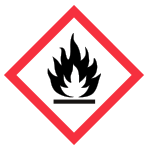
The flame pictogram is used for the following classes and categories:
- Flammable gases (Category 1)
- Flammable aerosols (Category 1 and 2)
- Flammable liquids (Category 1, 2 and 3)
- Flammable solids (Category 1 and 2)
- Pyrophoric liquids (Category 1)
- Pyrophoric solids (Category 1)
- Pyrophoric gases (Category 1)
- Self-heating substances and mixtures (Category 1 and 2)
- Substances and mixtures which, in contact with water, emit flammable gases (Category 1, 2 and 3)
- Self-reactive substances and mixtures (Types B*, C, D, E and F)
- Organic peroxides (Types B*, C, D, E and F)
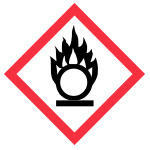
The flame over circle pictogram is used for the following classes and categories:
- Oxidizing gases (Category 1)
- Oxidizing liquids (Category 1, 2 and 3)
- Oxidizing solids (Category 1, 2 and 3)
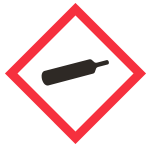
The gas cylinder pictogram is used for the following classes and categories:
- Gases under pressure (Compressed gas, Liquefied gas, Refrigerated liquefied gas, and Dissolved gas)
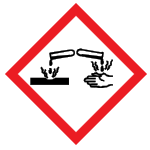
The corrosion pictogram is used for the following classes and categories:
- Corrosive to metals (Category 1)
- Skin corrosion/irritation – Skin corrosion (Category 1, 1A, 1B and 1C)
- Serious eye damage/eye irritation – Serious eye damage ( Category 1)
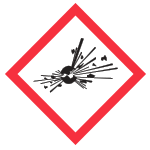
The exploding bomb pictogram is used for the following classes and categories:
- Self-reactive substances and mixtures (Types A and B*)
- Organic peroxides (Types A and B*)
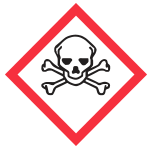
The skull and crossbones pictogram is used for the following classes and categories:
- Acute toxicity –
-
- Oral (Category 1, 2 and 3)
- Dermal (Category 1, 2 and 3)
- Inhalation (Category 1, 2 and 3)
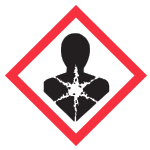
The health hazard pictogram is used for the following classes and categories:
- Respiratory or skin sensitization – Respiratory sensitizer (Category 1, 1A and 1B)
- Germ cell mutagenicity (Category 1, 1A, 1B and 2)
- Carcinogenicity (Category 1, 1A, 1B, and 2)
- Reproductive toxicity (Category 1, 1A, 1B and 2)
- Specific Target Organ Toxicity – Single exposure (Category 1 and 2)
- Specific Target Organ Toxicity – Repeated exposure (Category 1 and 2)
- Aspiration hazard (Category 1)
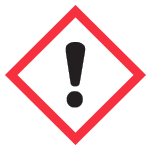
The exclamation mark pictogram is used for the following classes and categories:
- Acute toxicity – Oral, Dermal, Inhalation (Category 4)
- Skin corrosion/irritation – Skin irritation (Category 2)
- Serious eye damage/eye irritation – Eye irritation (Category 2 and 2A)
- Respiratory or skin sensitization – Skin sensitizer (Category 1, 1A and 1B)
- Specific target organ toxicity – Single exposure (Category 3)
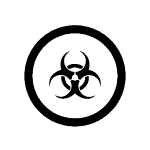
The biohazardous infectious materials pictogram is used for the following classes and categories:
- Biohazardous Infectious Materials (Category 1)
* Both the Flame and Explosive pictogram are used for Self-reactive substances and mixtures (Type B) and Organic peroxides (Type B).
NOTE: Physical Hazards Not Otherwise Classified and Health Hazards Not Otherwise Classified classes are required to have a GHS pictogram that is appropriate to the hazard identified.
Do all hazard classes and categories require a pictogram?
No. There are hazardous products that meet the criteria for a hazard class or category, but these classes and categories do not require a pictogram. The product label and Section 2 (Hazards Identification) of the SDS still require the signal word, hazard statement(s), and other required label elements.
WHMIS 2015 classes and categories that do not require a pictogram are:
- Flammable gases – Category 2
- Flammable liquids – Category 4
- Self-reactive substances and mixtures – Type G
- Organic peroxides – Type G
- Combustible dusts – Category 1
- Simple Asphyxiants – Category 1
- Serious eye damage/eye irritation – Eye Irritation – Category 2B
- Reproductive toxicity – Effects on or via lactation
Source: © Copyright 1997-2021 CCOHS